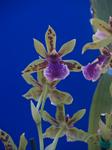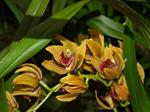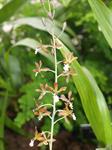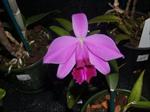 Become an Expert with Orchids
Become an Expert with Orchids
This course has been designed for:
- Enthusiastic Amateurs
- Nurserymen & Nursery Sales Staff
- Gardeners and Horticulturists
- People wanting to become Commercial Orchid Growers
COURSE STRUCTURE
The course is divided into eight lessons as follows:
1. Introduction
2. Orchid Culture
3. Propagation
4. Cymbidiums and Dendrobiums
5. Cattleyas, Vandas and Other Commonly Grown Orchids
6. Native Orchids
7. Growing Orchids as Cut Flowers, Baskets, Epiphytes and in Greenhouses.
8. Special Assignment
 LESSON AIMS
LESSON AIMS
- Understand the system of plant classification and naming
- Gain an insight into the appropriate way to grow a range of different orchid species.
- Understand common methods of Orchid Propagation
- Understand the basics of the structure, taxonomy and culture of Cymbidiums and Dendrobiums
- Learn about some of the more commonly grown orchids apart from Dendrobiums and Cattleyas
- Learn about orchids native to your locality
- Understand a range of alternative ways in which to grow orchids
- Research two commercial orchid growing establishments
WHAT YOU WILL DO IN THIS COURSE
- Compile a resource file or organisations and information sources relevant to orchids.
- Obtain and orchid flower; draw and label this flower.
- Review 56 different orchid species in detail.
 Obtain soil from two different areas (two different types of soils). Using the tests in the Lesson notes, do the following, name each of these soils and test the drainage of each soil.
Obtain soil from two different areas (two different types of soils). Using the tests in the Lesson notes, do the following, name each of these soils and test the drainage of each soil.
- Obtain (or make up) a potting mix which you consider appropriate for growing orchids.
- Visit a nursery or garden growing orchids. Notice how and where these plants are growing. Determine which plants are healthiest and assess the conditions in which they are growing.
- Obtain enough plant material to propagate four different orchids. Propagate these orchids vegetatively.
- Visit a nursery, or some other place which sells a wide range of different types of pots. Consider the properties of the pots you see for sale and their suitability for growing orchids in. Note down the prices of each.
- Investigate further into tissue culture processes specific to Orchids beyond the notes offered in the course.
- Determine which species of orchids are most commonly sold in your locality.
- Carry out research and look through any references you have and determine any orchid genera (not yet covered in this course), which are suited to growing in a tropical or sub-tropical climate.
- Visit a native plant nursery which sells a range of native orchids. List differentat orchid varieties which are being grown in your locality.
- Visit a florist shop. Notice what orchids are being sold; how they are presented for sale, how they are stored etc
- Evaluate the cultural practices observed (or investigated) in the different enterprises which you considered in your set task.
| Number of Assignments |
8 |
| Duration (approx) |
100 hours |
Do You Know What a Laelia is?
 Laelia is closely related to Cattleya.
Laelia is closely related to Cattleya.
Consisting of approximately 30 species and with many varieties in existence, Laelia is a genus of epiphytes that are native to Central and South America, predominantly from Brazil.
Pseudobulbs each carry one or two fleshy leaves that are folded along their length. The flowers have petals that are wider than sepals. Both petals and sepals are spreading and the lip is variable and can be simple or 3-lobed.
Culture
Ideally the plant will have minimum temperatures in winter of 13°C minimum and a summer maximum temperature of around 22oC. Most do well, when they are grown in open hanging baskets.
Propagate by division in spring.
Cultural treatment does vary according to the species. Some need a definite rest period without watering, while others need to be watered throughout all seasons, as they continue growing all year round.
Cultivars
There are two main groups of Laelia that are commonly cultivated. They consist of:
- Mainly larger flowering plants similar to Cattleya labiata. They are a clavate bulbed species, and do not need a rest in winter between flowering periods.
- Usually smaller flowering plants, often with ovoid pseudobulbs. They generally have tall slender flowers that are suitable for growing in humid, warm places. They need a good rest over winter.
L. albida has a short pseudobulb with 17 cm (7 inch) long leaves. Fragrant white flowers are tinged rose and pink. Lip is three lobed with yellow crests down the centre.
L. anceps has pseudobulbs to 12 cm (4.8 inches) long, leaves to 18 cm (7.2 inches) long, and flower spikes to almost 1 metre long. It has the largest flowers of all cultivated Laelias. Flower characteristics are extremely variable. Flowers can reach 10 cm (4 inches) across, occurring in late autumn or winter; commonly pinkish with a yellow-marked, and a purplish 3-lobed lip in centre. Other varieties have pale to deep rose flowers with a crimson lip. This species needs a definite rest in winter after flowering, and likes heat and humidity over summer.
L. crispa has pseudobulbs to 30 cm (12 inches) long, leaves to 30 cm (12 inches) long, and flower spikes to 30 (12 inches) cm long with 4 to 7 flowers per stem. Flowers are white and purple, lips have purple margins and a yellow throat, are 3-lobed, and occurring in summer to early winter. L. crispa enjoys sun and needs humidity in summer. It must be rested in winter.
L. dormaniana grows to 40 cm (16 inches) tall with thin round stems and 2 to 4 flowers per spike. Each flower is around 8 cm (3.2 inches) across, with greenish brown petals and sepals, and a rose to purplish lip.
L. grandis produces brown-yellow petals and sepals with rose-purple veins. L. grandis var. tenebrosa has sepals and petals of yellow and a purple trumpet shaped lip, with a white margin and purple veins.
L. jongheana does not need a rest. Its flowers grow to 12 cm (4.8 inches) across and are rose to purplish, with yellow markings.
L. lobata has leathery leaves to 10 cm (4 inches) long and flower spikes to 20 cm (8 inches) long with 2 to 5 flowers per spike. These flowers rose-purple with deeper coloured veins, and purplish lip. It needs a rest in winter.
L. pumila has pseudobulbs to 10 cm (4 inches) long and leaves to 10 cm (4 inches) long. The flower stems grow to 8 cm (3.2 inches) long bearing a single flower; most commonly purplish flowers with yellowish throats, mainly in autumn. Cultivars of L. pumila can be variable. It does not require resting (so water all year).
L. purpurata has pseudobulbs to 45 cm (18 inches) long, leaves to 40 cm (16 inches) long, and flower spikes to 30 cm (12 inches) long.
There are with 3 to 7 flowers per spike, often with white to rose flushed flowers and red-purple lip, and a yellow throat with purple venation. Flowers occur in spring. Flower colour can vary greatly between varieties. L. purpurata does not require a rest period.
Hybrids
Many intergeneric hybrids are grown. Crosses with Cattleya (called Laeliocattleya) in particular are common.